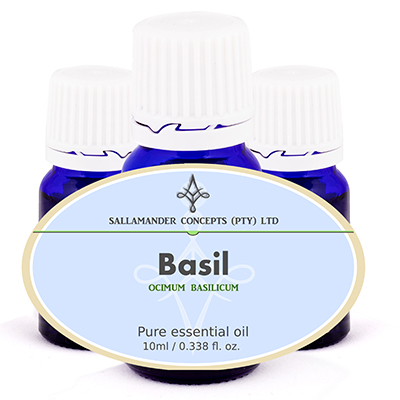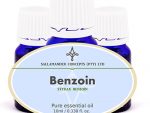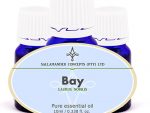Basil essential oil information
Our basil essential oil is extracted from the herb Ocimum basilicum, of the Lamiaceae (Labiatae) family. It is also known as European, French, common or sweet basil.
This crisp smelling essential oil is often used in aromatherapy, as it awakens the mind to clarity of thought, steadies the nerves, while easing sinus congestion, cooling down fevers and treating menstrual problems.
Oil properties
The oil has a watery viscosity and is pale greenish-yellow in color. The aroma is clear, light and peppery and gives a sweet, green top note to blends. The essential oil comes from North Africa, Cypress, Seychelles and Europe.
Origin of basil essential oil
Basil originates from tropical Asia and the Pacific Islands, but is now cultivated throughout Europe and the USA. The plant is an annual hairy herb growing up to 1 meter (3 feet).
The flowers range from white to pink, depending on the species and attract swarms of bees in summer time.
Basilicum comes from the Greek word ‘basilikós’ meaning ‘king’ or ‘royal’, and this suggests the idea that basil was thought to be a ‘king’ amongst plants.
A much favored herb in India, it is held sacred to Krishna and Vishnu, and the leaves are even chewed before taking part in religious ceremonies.
It is said to have protective qualities, a Basil leave is placed on the chest of a Hindu when resting. It is also used in Ayurvedic and Chinese medicine.
Extraction of basil essential oil
The oil is typically extracted by steam distillation from the leaves and the flowering tops.
Chemical composition of basil essential oil
Basil oil has various chemical compounds that include a-pinene, camphene, b-pinene, myrcene, limonene, cis-ocimene, camphor, linalool, methyl chavicol, y-terpineol, citronellol, geraniol, methyl cinnamate and eugenol.
Precautions when using basil essential oil
Basil essential oil produced from the Ocimum basilicum herb is generally thought to be safe for use on the skin as long as it is suitably diluted. It is reported that basil essential oil has the potential to be a skin irritant and may cause an allergic reaction. Care should be taken and use should be discontinued should irritation or an allergic reaction present.
There are other conflicting reports surrounding the use of this oil:
Some report that basil essential oil should not be used in pregnancy; some say that it is safe.
Some research states that basil contains methyl cinnamate or methyl chavicol and that these constituents are carcinogenic and that this essential oil is therefore carcinogenic – as shown when the oil was tested on rodents. Other research says that the results of animal testing cannot be extrapolated to humans as the dose is considerably higher in animal testing than the ingestion of basil is in its normal dietary form as found in humans.
The WHO reports that basil pesto is safe for consumption. One assumes that basil pesto would contain concentrated amounts of all the constituents found in the plant and therefore the essential oil can be safely used in Aromatherapy if humans can eat the herb in such concentrated form without any warnings.
So far, we cannot find any conclusive evidence that any side effects in pregnancy were caused by basil essential oil. However, we join the majority of essential oil providers and advise that this oil should not be used during pregnancy (this decision is based on there being conflicting data and our wanting to err on the side of safety).
We also cannot find any proof that basil essential oil caused cancer in humans – bearing in mind that basil oil and the herb have been used and consumed for at least 100 years.
Confusion may be caused by the differing levels of constituents that may be found in cultivars of the herb Ocimum basilicum and that research into this is incomplete.
Basil essential oil derived from Ocimum basilicum -with the Linalool chemotype (CT), has been tested and is recognised as safe for use in Aromatherapy at appropriate dilution rates.
Please read our page with heading: Safety with Essential Oils before using this oil.
We recommend the following book as an excellent resource regarding safety:
Essential Oil Safety: A Guide for Health Care Professionals by Robert Tisserand & Rodney Young (#ad)
Therapeutic properties of basil essential oil
The therapeutic properties of basil oil are analgesic, antidepressant, antispasmodic, anti-venomous, carminative, cephalic, diaphoretic, digestive, emmenagogue, expectorant, febrifuge, insecticide, nervine, stomachic, sudorific, tonic and stimulant.
Uses of basil essential oil
Basil oil is a good tonic for the treatment of nervous disorders and stress related headaches, migraines and allergies. It is used to clear the mind and relieve intellectual fatigue, while giving clarity and mental strength.
It has a beneficial action on the respiratory tract and is often used for asthma, bronchitis and sinus infections. It furthermore is also effective in cases of constipation, nausea, vomiting and cramp, and is also good when used for menstrual problems.
Due to the emmenagogue properties, it is often used to relieve scanty periods and normalizing menses.
It helps to minimize uric acid in the blood, thus relieving gout. It is useful in arthritis, and when used on the skin, it helps to control acne.
In general it refreshes the skin and can also be used on insect bites.
Suggested dilution rates
On the skin:
Healthy adult with unbroken skin
- Face and Neck: 0.2% to 1.5%
- Body: 1,5% to 3%
- Bath: 1% to 3%
Healthy Infant from 3 months to 24 months:
- Face and Neck: Avoid
- Body: up to 0.25%
- Bath: up to 0.25%
Healthy Young Child from 2 years to 6 years:
- Face and Neck: Avoid
- Body: up to 1%
- Bath: up to 1%
Healthy child from 6 years to 15 years:
- Face and Neck: 0.2% to 1,5%
- Body: 1,5% to 2%
- Bath: 1,5% to 2%
In Pregnancy and when breastfeeding:
- We suggest that this oil be avoided during pregnancy
- Certain professionals limit use of Basil (Linalool CT) essential oil to a maximum dilution rate of 1% in pregnancy
- We suggest that this oil be avoided when breastfeeding.
General:
- When using for the first time – Always use the lowest dilution rate and build up slowly to the maximum. Stop if irritation or allergy occurs
Burners and vaporizers
In vapor therapy, basil oil can be used for migraines, headaches and to help increase concentration and clear the mind. Use 4 to 8 drops.
Summary
Basil oil is a very beneficial oil and can be helpful not only for headaches and migraines, but also has an uplifting effect on depression.
It is effective in digestive disorders, ranging from nausea to hiccups, and for infections in the respiratory tract. It is useful for wasp and insect bites, particularly that of mosquitoes.
Basil oil blends well with
Although essential oils blend well with each other, Basil oil goes particularly well with oils such as: Bergamot, Black Pepper, Cedarwood, Fennel, Ginger, Geranium, Grapefruit, Lavender, Lemon, Marjoram, Neroli and Verbena.





